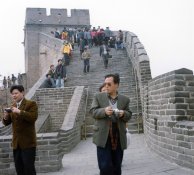asteroid_death
Member
- Joined
- Jul 27, 2013
- Messages
- 46
- Format
- Multi Format
First off, apologies if this is a redundant topic, I am having trouble finding 'clear' answers to my questions regarding this scanner.
I just purchased the v600 to scan my 120 film and I want to try to make sure it's going to meet my standards before the return policy period lapses.
I went with the v600 because it's cheaper than the 700s but I am having trouble getting sharp scans, and I'm not certain if it's my technique or if I'm just unimpressed with the v600's capabilities. I have been using the minolta dimage IV for my 35mm and I'm generally very happy with the results, but as it stands the IV is able to resolve more information from my 35mm negatives than the v600 can from 120. Having said that though, the IV is pretty cut and dry when it comes to scanning, and the v600 seems to require some trickery to get sharp scans.
At first I was putting the 120 in emulsion side up, which resulted in blurry scans (perhaps because the film won't stay flat), but then flipping the film over and scanning emulsion down, so that the film curled towards the glass, resulted in slightly sharper scans. So now I am wondering if I should invest in the betterscanning glass and mount (which I've read mixed reviews about) although I think these accessories may just be a pricey addition to a device unable to produce good results.
I am aware that there are very limited options when it comes to medium format scanning, but since my minolta seems to be doing a great job with 35, I'm thinking of just getting a dimage multi to scan my 120, regardless of the lack or support. I do want to like the Epson though, since drivers and software are available for it. So basically I'm wondering out of the people that use epsons on this board, what is the 'best' technique to render sharp results, and do the betterscanning accessories actually provide a significant improvement when scanning 120 or is it not worth it? $80 for the mount and $30 for the glass seems pricey to me, and I haven't found many example photos of 120 scans with and without, so that's why I'm posting here.
I am strictly concerned with the sharpness and resolution of the scans and not the color representation (a separate issue).
Any insight is appreciated.
Minolta IV w/ Ektar 35

Epson V600 w/ Ektar 120

ALSO, you may note the highlight clipping in the V600 photo. I don't know how to fix this.
I just purchased the v600 to scan my 120 film and I want to try to make sure it's going to meet my standards before the return policy period lapses.
I went with the v600 because it's cheaper than the 700s but I am having trouble getting sharp scans, and I'm not certain if it's my technique or if I'm just unimpressed with the v600's capabilities. I have been using the minolta dimage IV for my 35mm and I'm generally very happy with the results, but as it stands the IV is able to resolve more information from my 35mm negatives than the v600 can from 120. Having said that though, the IV is pretty cut and dry when it comes to scanning, and the v600 seems to require some trickery to get sharp scans.
At first I was putting the 120 in emulsion side up, which resulted in blurry scans (perhaps because the film won't stay flat), but then flipping the film over and scanning emulsion down, so that the film curled towards the glass, resulted in slightly sharper scans. So now I am wondering if I should invest in the betterscanning glass and mount (which I've read mixed reviews about) although I think these accessories may just be a pricey addition to a device unable to produce good results.
I am aware that there are very limited options when it comes to medium format scanning, but since my minolta seems to be doing a great job with 35, I'm thinking of just getting a dimage multi to scan my 120, regardless of the lack or support. I do want to like the Epson though, since drivers and software are available for it. So basically I'm wondering out of the people that use epsons on this board, what is the 'best' technique to render sharp results, and do the betterscanning accessories actually provide a significant improvement when scanning 120 or is it not worth it? $80 for the mount and $30 for the glass seems pricey to me, and I haven't found many example photos of 120 scans with and without, so that's why I'm posting here.
I am strictly concerned with the sharpness and resolution of the scans and not the color representation (a separate issue).
Any insight is appreciated.
Minolta IV w/ Ektar 35

Epson V600 w/ Ektar 120

ALSO, you may note the highlight clipping in the V600 photo. I don't know how to fix this.
Last edited by a moderator:









